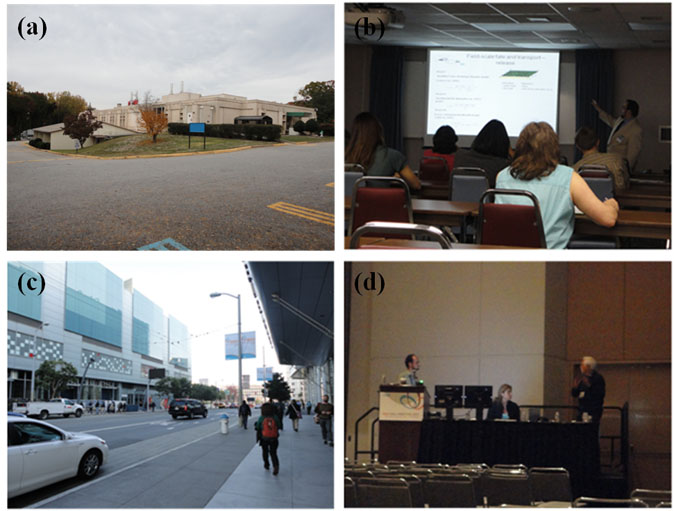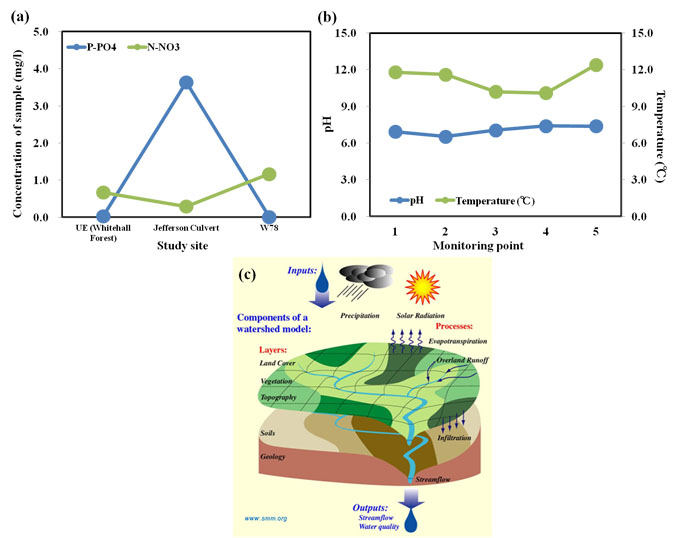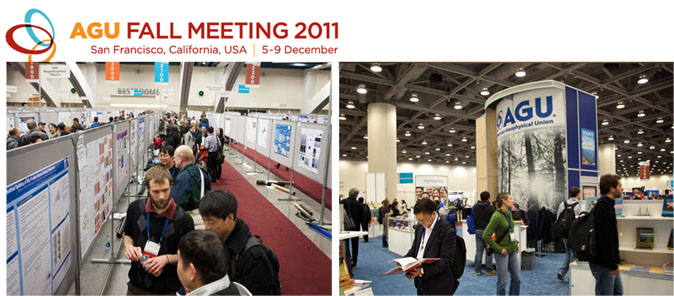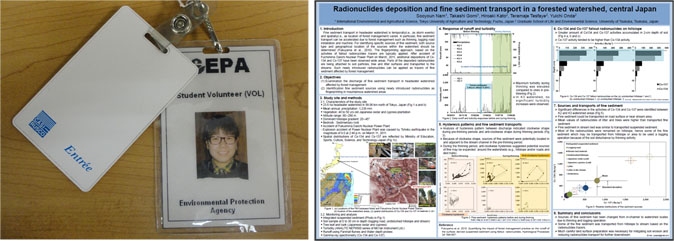Report
Internship: U.S. Environmental Protection Agency, Office of Research and Development, Ecosystem Research Division/ American Geophysical Union Fall Meeting
Host: U.S. Environmental Protection Agency, Office of Research and Development, Ecosystem Research Division, Athens, Georgia, USA
Duration: 7 November – 10 December 2011
Internship in the Ecosystems Research Division,
Environmental Protection Agency (EPA), including the AGU fall meeting
Sooyoun Nam ![]()
International Environmental and Agricultural Science (IEAS)
Key words: field-oriented, environment, Asia, Africa, suspended sediment (SS), SWAT modeling
 |
| Figure 1. My internships activities: (a) the Ecosystem Research Division; (b) a seminar organized by the division; (c) the street outside the AGU fall meeting in San Francisco; (d) a presentation at the AGU meeting |
1. Activities during the internship
During my internship program from November 7 to December 10 in the Ecosystem Research Division (ERD) of the United States Environmental Protection Agency (EPA), I had the opportunity to be a member of ERD working on contaminants, nutrients, and biota in environmental systems, and the development of mathematical models to assess the response of aquatic systems, watersheds and landscapes to stresses from natural and anthropogenic sources. My visit lasted for four weeks.
Here is a week-by-week summary of my activities. In the first week, I attended two types of orientation: security and CTS computer support. In addition, I attended a small meeting on statistics with the title of ‘Profiting from prior information in Bayesian analyses of ecological data’, introduced by Dr. Katie Price, who is a post-doctoral geographer in ERD of EPA. I was sincerely thrilled to attend and expectant because of the chance to hear what they had to say and to improve my own knowledge. In the second and third weeks I observed sample collection at the study site with Dr. Roger A. Burke, who is a researcher in biological chemistry in the ERD of EPA. I learned the ICS-2000 method of analysis, for analyzing chloride (Cl) and nitrate-nitrogen (NO3-N) from Dr. Burke. Dr. Price taught me about the process of SWAT (Soil and Water Assessment Tool) modeling, and I attended a seminar, called ‘Field-scale fate and transport infiltration’. I had never studied SWAT modeling previously, so it was very difficult to understand, although it was useful studying the many scientific aspects of the tool.
In the fourth week, I learned parameter calibration and upscaling related to modeling, and I tested for N-NO3 and P-PO4 using a spectrophotometer. Before I began, a lab technician taught me how to perform the analysis and the uses of the machine. We made reagents for doing a calibration test for N-NO3 and P-PO4 and prepared to collect samples at the Whitehall Forest and Jefferson Culvert (Figure 1a). I was interested to learn the different methods of chemical analysis using the different equipment. Although this experiment was very sensitive and complex, it was a valuable experience.
Towards the end of my internship with the EPA, I attended the American Geophysical Union (AGU) fall meeting in San Francisco from 3 to 9 December. There I learned about the various issues relating to environmental problems from the oral and poster presentations, and I had a chance to receive comments on my own presentation and to have a discussion with researchers (Figure 1b).
2. Experience and achievements resulting from the internship
 |
Figure 2. |
I learned about taking an interdisciplinary approach through a variety of experiences, including attending a small meeting, attending a seminar, and participating in experiments at the ERD for four weeks. In other words, this research allowed me to freely communicate with many researchers on interdisciplinary projects, which led me to see the broader aspects and different viewpoints related to recent studies. In addition, I was interested to see how they approached one theme with different ideas and various researchers, even if they were not directly related to this theme.
In the ERD, I was a member of the bio-ecosystem team looking at the behavior of contaminants, nutrients, and biota in environmental systems, and modeling these to assess the response of watersheds and landscapes. Thus, I was able to learn analytical methods for assessing N-NO3 and P-PO4. P-PO4 requires preparing reagents for the samples. After this, I checked the calibrations of N-NO3 and P-PO4 (R2 = 0.9998-0.9999), and then analyzed the samples using the spectrophotometer. The greatest advantage of the spectrophotometer is that it is convenient to use and saves time on the analysis.
The results are presented in Figure 2a. I was able to participate only in pre-testing for monitoring due to the dry season. In addition, I participated in an experiment measuring water flow (velocity) and pH in a stream located near to several livestock farms. The reason for sampling at this location was that livestock farms can accelerate the increase of suspended sediment. According to several research papers, high concentrations of suspended sediment (SS) can have an impact on fish and aquatic ecosystems (Newcombe and MacDonald, 1991). These broader concerns have prompted studies of the impacts of land use on suspended sediment concentrations (SSC) in streams. I also tested the pH in the stream (Figure 2b). Although no significant pH and temperature increases were observed, point 5 was a little higher than the others because of its location near a reservoir.
I learned about SWAT modeling, which is based on hydrological moldering in the watershed. Dr. Price explained the process of SWAT modeling. She said it involves simulating stream flow with a SWAT watershed model, and then calibrating each data type for each watershed and simulated stream flow and comparing these with the United States Geological Survey (USGS) observed stream flow (Figure 2c).
At the AGU fall meeting I gave a poster presentation with the title ‘Radionuclide deposition and fine sediment transport in a forested watershed, central Japan, on December 8, 2011’. At this conference, I had the opportunity to see updated information from projects conducted by EPA scientists (not only from my host group but from across the USA). I also introduced my project at the Tokyo University of Agriculture and Technology (TUAT) on developing an international network for tackling and sharing information on environmental and agricultural problems, through a poster presentation. I participated in an evaluation of my poster presentation by a judge. At that time, I received questions and comments that will enable me to clarify what I will reinforce and revise in the interpretation of the results of my studies, and I discussed the topic with many students and researchers.
 |
| Figure 3. Poster presentation and exhibition at the AGU fall meeting (Source of photos: http://sites.agu.org/fallmeeting/) |
3. Relationship between the internship experience and future career development as a field-oriented leader in Asia and Africa
As a result of this internship experience I expanded my scientific and practical knowledge, and heard different views on approaching and developing watershed systems, including mitigation of environmental disasters such as flooding and water pollution. In particular, I learned a great deal about water pollution from participating in an experiment involving chemical analysis and a field survey, and about watershed systems from the SWAT modeling. I also gained valuable knowledge, skills and experience that will help me to become a leader in the environmental sector.
I realized that the same environmental problems will be occurring under similar environmental and socioeconomic conditions when we compare the geomorphology and geography across Asia and Africa. As a result, these experiences, including learning about interdisciplinary project teams, will be strongly connected to my future career intackling environmental concerns, including aspects of forest management and sediment dynamics in South Korea, as well as in the general Asian and African regions.
When I return to South Korea after studying in Japan, I will be able to make use of the various methods relating to environmental problems that I learned through this internship experience, and will be able to approach anyone in Asia or Africa to inform them of the importance of forest management for preventing global environmental problems. Lastly,I would like to thank my hosts, Dr. Sidle, Dr. Price, and Dr. Burke, for all their kind help while I was at the ERD. I wouldalso like to thank FOLENS and Professor Takashi Gomi for enabling me to participate in this internship, which was a very valuable experience for me.
 |
| Figure 4.My name tag and poster presentation |
References
Newcombe CP, MacDonald DD. 1991. Effects of suspended sediments on aquatic ecosystems. North American Journal of Fisheries Management 11: 72–82.
Price K, Purucker T, Kraemer S, Babendreier J. 2011. Presentation: Comparison of varied precipitation datasets for use in watershed modeling. Ecosystem Research Division (ERD) of the United States Environmental Protection Agency (EPA).